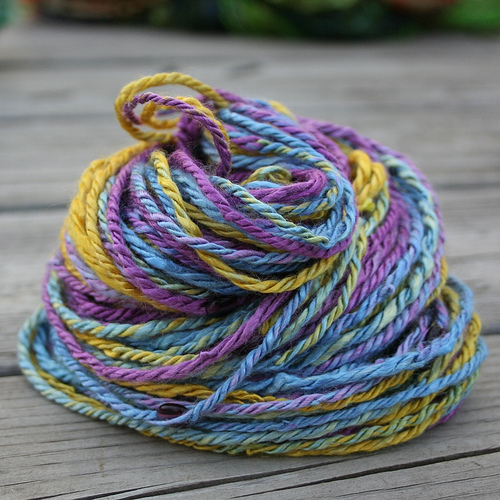Navajo plying: An excellent technique for your spinning toolkit

I recently faced a new crisis with spinning. I had bought a multi-colored braid of roving with color segments of green, blue and purple. I wanted to keep those color changes in the yarn, with a minimum of "barber pole" style striping.
I first tried splitting the roving in half lengthwise. I spun up the two halves separately, and in theory when I plied them together, the color transitions should have matched up. IN THEORY. In practice, it all went horribly wrong. Well, that's overly dramatic. It didn't go the way I planned, let's just say that.
This was clearly a situation for Navajo plying.
This technique basically lets you ply a single strand of yarn back on itself. It is simple in concept, but it can be a little bit tricky and fumbling in practice, especially at first. I will pass along the suggestion someone gave me, which is to start by practicing with a strand of some cheap commercial yarn until you get the hang of it.
If you have ever done a single chain crochet, or braided a single strand of rope back on itself through a loop, then you know the basic mechanics. You make a loop, pull the main strand through that loop, then hold all three together and ply them. Leave a little bit of loop left open at the end, and pull another strand through.
This technique preserves color changes well, and is ideal for plying yarn that has long color changes. It takes a little more time (especially with the drop spindle, which is what I use). But the results are definitely worthwhile. And on the up side, it uses up every last bit of your singles, without any leftovers. On the down side, since you're making a three-ply yarn out of your singles, your yardage is reduced by 2/3rds. But I personally like the balanced look of a three-ply yarn. And I definitely liked the look of the color changes in my finished yarn!
Here are some YouTube videos that demonstrate the technique:
- How to Navajo Ply: Demystified and Unraveled
- How to Navajo ply on a drop spindle with Rachael from Paradise Fibers
- Tammy Rizzo's Navajo Ply-on-the-Fly Technique
Image courtesy Flickr/temptressyarn

0 comments